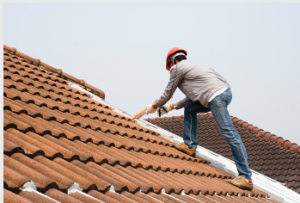If your roof leaks, it can cause extensive damage and even require a full-on replacement. In addition, as materials in your roof age and break down over time, leaks may develop that must be addressed immediately to avoid costly repairs.
The initial step should be to locate the source of the leak. It may not be simple, but it’s necessary to minimise damage until a repair can be made.
Sagging Bulge
 A sagging bulge or leaking roof Adelaide in the ceiling may indicate water accumulation nearby. While it may be tempting to ignore this bulge and let it continue to sag independently, doing so could cause further harm in the affected area.
A sagging bulge or leaking roof Adelaide in the ceiling may indicate water accumulation nearby. While it may be tempting to ignore this bulge and let it continue to sag independently, doing so could cause further harm in the affected area.
It is a signal to take action quickly. Use a screwdriver or other sharp object to carefully puncture the lowest point of the bulge and place a bucket underneath to catch any water that leaks out. Depending on the issue’s size, you may need to create several holes to relieve pressure.
One common cause of a sagging roof is water damage to the sheathing or layer of wood that covers your home’s rafters and trusses. With time, this can rot or decay and cause parts of your roof to sag.
You can resolve this problem by replacing the damaged sheathing with new material. However, if you don’t have enough time or funds for this, calling a roofing contractor is your best bet.
Some homeowners may not notice a sagging ceiling in an unorthodox part of their house, such as an attic or basement. Still, it’s wise to have it evaluated by an expert before it causes further deterioration and severe issues with your home.
Many times, sagging ceilings are caused by seasonal temperature changes. As your home’s foundations and frameshift, the plasterboard, cornices and ceiling can expand or contract due to this movement – eventually leading to sagging.
Bulges in ceilings may be caused by improper installation of drywall or other ceiling materials such as cement or plaster. They could also indicate water damage in your attic or other parts of your home.
Sagging ceilings can be hazardous, as they could collapse on you or others if not corrected properly. If left unrepaired, they also damage other parts of your home, such as carpets, floor tiles and furniture.
Dark Spots on the Walls
A leaking roof, condensation, or mould growth may cause dark spots on walls or ceilings. If you observe these stains, contact an expert for identification and remediation.
One of the first signs of a roof leak is a brown or yellow stain on the ceiling. These spots look like puddles with faint rings around them and may sag or sink, signifying water has seeped through into your roof.
The most common cause of these stains is corrosion on fasteners that attach drywall to wall and ceiling framing, when relative humidity levels or air moisture increase, drywall screws and nails will be corroded.
Another common cause of stains on walls and ceilings is thermal tracking (also referred to as ghosting or ghost stains, or thermal bridging stains) combined with insulation defects. These stains appear regularly along the surface of walls or ceilings, becoming darker as they move in this direction.
Stains on walls or floors can be tricky to diagnose if there are more than a few, but they may indicate potential insulation or air movement issues in a building.
No matter the cause of these stains, they are easily removed with 1/4 bleach and 3/4 water solution. Apply to the colour, sit for 5-10 minutes, and then scrub away with a soft brush. They may need leaking roof Adelaide professional assistance if the stains are too large for this treatment to be effective.
Water Dripping
Water can seep through your roof during heavy downpours, causing extensive damage to your home and its contents. Therefore, the problem must be rectified promptly.
Check to see if any water is pooling around where you’re experiencing the drip. If so, put a bucket underneath to catch it and let the liquid drain downward; this may need to be done several times, depending on how big of an issue this is.
Another way to determine if your roof leaks are by scanning inside for signs. Use a flashlight and search for any puddles or soft spots that might indicate an issue.
As a general guideline, check accessible areas like your attic, crawl space or utility closet for signs of roof leaks first. These often serve as the first places to inspect for issues.
Once you’ve identified the leak’s location, it’s time to determine its source. Usually, this will be from either your attic or another part of the roof.
Puncturing a roof with fibreglass insulation can be tricky without professional assistance. Similar risks exist with shingles and other roofing materials.